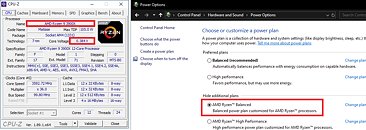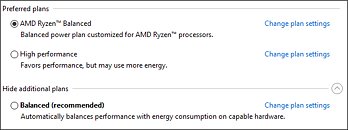Mar 29th, 2025 19:27 EDT
change timezone
Latest GPU Drivers
New Forum Posts
- Free Games Thread (4600)
- GPU Crashing System From Hibernation (7)
- Upgrade from a AMD AM3+ to AM4 or AM5 chipset MB running W10? (46)
- Overclocking ROG Astral 5080 - Power Limited (1)
- Undervolting help for newbie - msi vector i9 13980 hx rtx 4080 (13)
- RTX 5000 Series Stable Driver? (8)
- Dell Workstation Owners Club (3314)
- Display panel recommendation for low brightness and BFEP (0)
- Intel Arc A770 LE Temperature (4)
- Throttlestop undervolt asus tuf f15 i5-10300H NEED HELP UNCLEWEBB (7)
Popular Reviews
- Sapphire Radeon RX 9070 XT Pulse Review
- ASRock Phantom Gaming B850 Riptide Wi-Fi Review - Amazing Price/Performance
- Samsung 9100 Pro 2 TB Review - The Best Gen 5 SSD
- Assassin's Creed Shadows Performance Benchmark Review - 30 GPUs Compared
- Sapphire Radeon RX 9070 XT Nitro+ Review - Beating NVIDIA
- be quiet! Pure Rock Pro 3 Black Review
- Palit GeForce RTX 5070 GamingPro OC Review
- ASRock Radeon RX 9070 XT Taichi OC Review - Excellent Cooling
- Pulsar Feinmann F01 Review
- AMD Ryzen 7 9800X3D Review - The Best Gaming Processor
Controversial News Posts
- MSI Doesn't Plan Radeon RX 9000 Series GPUs, Skips AMD RDNA 4 Generation Entirely (142)
- Microsoft Introduces Copilot for Gaming (124)
- AMD Radeon RX 9070 XT Reportedly Outperforms RTX 5080 Through Undervolting (119)
- NVIDIA Reportedly Prepares GeForce RTX 5060 and RTX 5060 Ti Unveil Tomorrow (115)
- Over 200,000 Sold Radeon RX 9070 and RX 9070 XT GPUs? AMD Says No Number was Given (100)
- NVIDIA GeForce RTX 5050, RTX 5060, and RTX 5060 Ti Specifications Leak (96)
- Retailers Anticipate Increased Radeon RX 9070 Series Prices, After Initial Shipments of "MSRP" Models (90)
- China Develops Domestic EUV Tool, ASML Monopoly in Trouble (88)
News Posts matching #Ryzen Balanced
Return to Keyword Browsing
AMD Readies AGESA ComboAM4 1.0.0.3ABB, Addresses Several Issues Affecting 3rd Gen Ryzen
AMD today addressed multiple issues with its 3rd generation Ryzen processors through a highly-recommended update to its Chipset Driver software. To begin with, it stated that several users noticed anomalous behavior with 3rd generation Ryzen chips where the voltages and clock-speeds would be raised as the processor would misinterpret low-scale performance requests from certain software as a request to unlock higher performance states (combinations of higher clock-speeds and voltages to support them). This first came to light when users reported abnormally high voltages at idle when performance was measured by certain software that caused the Observer Effect. The new version 1.07.29 of AMD Chipset Drivers refine the AMD Ryzen Balanced Windows power scheme to be more aware of low-priority workloads and ensure the right state when the system is idling. AMD recommends Ryzen Master software. Version 2.0.0.1233 (or later), as they have fixes to the hardware monitoring module.
The AMD Chipset Drivers 1.07.29 also includes a "beta" fix for the bug that rendered "Destiny 2" unplayable on machines powered by 3rd generation Ryzen processors. The company had earlier tried to fix this bug through an update to its AGESA processor microcode, through ComboAM4 1.0.0.3ABA, although that particular version, not to be confused with the widely circulated 1.0.0.3AB, was found to be buggy and pulled. AMD said it's working on a newer version of AGESA, version ComboAM4 1.0.0.3ABB, which will include "a more comprehensive solution" to the bug affecting "Destiny 2."
The AMD Chipset Drivers 1.07.29 also includes a "beta" fix for the bug that rendered "Destiny 2" unplayable on machines powered by 3rd generation Ryzen processors. The company had earlier tried to fix this bug through an update to its AGESA processor microcode, through ComboAM4 1.0.0.3ABA, although that particular version, not to be confused with the widely circulated 1.0.0.3AB, was found to be buggy and pulled. AMD said it's working on a newer version of AGESA, version ComboAM4 1.0.0.3ABB, which will include "a more comprehensive solution" to the bug affecting "Destiny 2."

Reports of Ryzen 3000 High Idle Voltage Exaggerated, a Case of the "Observer Effect"
With AMD's 3rd generation Ryzen processors finally falling into the hands of PC enthusiasts, many early-adopters are taking to tech communities such as ours, to share their experiences with others. A trend appears to be emerging of users reporting higher-than-usual voltages for these processors when idling. AMD investigated this phenomenon, and declared this to be a non-issue. Apparently, most modern CPU monitoring utilities cause what is known as "the observer effect:" the process of measuring the processor's load itself causes load on the processor.
In case of the Ryzen "Matisse" processors, monitoring software appear to be polling each processor core for load by sending it instruction at a high rate of speed - sending them a workload of 20 ms every 200 ms. This causes the processor's embedded firmware to think that the cores are being subjected to workload, and it responds by increasing the clock-speeds, and proportionately voltages of all CPU cores. Monitoring software poll each CPU core, and so core voltages are raised across the chip.
In case of the Ryzen "Matisse" processors, monitoring software appear to be polling each processor core for load by sending it instruction at a high rate of speed - sending them a workload of 20 ms every 200 ms. This causes the processor's embedded firmware to think that the cores are being subjected to workload, and it responds by increasing the clock-speeds, and proportionately voltages of all CPU cores. Monitoring software poll each CPU core, and so core voltages are raised across the chip.

AMD Releases Chipset Drivers 17.10 WHQL with Ryzen Balanced Power Plan
AMD today released its latest platform core-logic (chipset) drivers for Windows 10, 8.1, and 7. The new version 17.10 WHQL chipset drivers are particularly important for AMD Ryzen platform users, as it installs a new Windows power-management plan called "Ryzen Balanced Power." This plan is better than the "Balanced" power plan Windows ships with, in that it hands over more power-management from the OS over to the silicon-level SenseMI power-management logic of Ryzen processors, which has more fine-grained voltage and clock-gating over cores, and which would otherwise cause latency issues with OS-level power-management using P-state triggers. The power plan is detailed at length in our older article. The power-plan is installed on machines with AMD A320, B350, and X370 chipsets. Grab the drivers from the link below.DOWNLOAD: AMD Chipset Drivers 17.10

AMD Releases Balanced Power Plan for Windows; Optimized for Ryzen Processors
In another Community Update from Robert Hallock, some more developments on the platform have been announced, after the last one's commitment to upcoming updates. AMD has done good on their promise for an optimized power profile for Windows systems that better leverages Ryzen's design and features.AMD's SenseMI technology allows the processor to fine-tune voltages and frequency on-the-fly, with a much higher granularity and lower latency than any software-based solution - such as Windows 10's power plans. These transitions between frequencies and voltages are governed by "P-States", which are frequency/voltage combinations requested by the operating system.
It so happens that Windows 10's Balanced power plan delays changes towards faster P-states - which bring increased frequency and voltage and hence, power consumption - so as to save more power. However, this means that there is an increased delay (latency) between the moment more processing power is required of the Ryzen processor and the moment the processor is allowed to change P-states to deliver it. Add to this the fact that Ryzen takes a significant performance hit with core-parking enabled, and Windows 10's balanced power plan attempts to park all logical processors beyond the first 10% whenever possible means that most of Ryzen's cores will have to be unparked before they can process any kind of workload - and this in itself incurs in an increased latency and, therefore, performance penalty.
It so happens that Windows 10's Balanced power plan delays changes towards faster P-states - which bring increased frequency and voltage and hence, power consumption - so as to save more power. However, this means that there is an increased delay (latency) between the moment more processing power is required of the Ryzen processor and the moment the processor is allowed to change P-states to deliver it. Add to this the fact that Ryzen takes a significant performance hit with core-parking enabled, and Windows 10's balanced power plan attempts to park all logical processors beyond the first 10% whenever possible means that most of Ryzen's cores will have to be unparked before they can process any kind of workload - and this in itself incurs in an increased latency and, therefore, performance penalty.
Mar 29th, 2025 19:27 EDT
change timezone
Latest GPU Drivers
New Forum Posts
- Free Games Thread (4600)
- GPU Crashing System From Hibernation (7)
- Upgrade from a AMD AM3+ to AM4 or AM5 chipset MB running W10? (46)
- Overclocking ROG Astral 5080 - Power Limited (1)
- Undervolting help for newbie - msi vector i9 13980 hx rtx 4080 (13)
- RTX 5000 Series Stable Driver? (8)
- Dell Workstation Owners Club (3314)
- Display panel recommendation for low brightness and BFEP (0)
- Intel Arc A770 LE Temperature (4)
- Throttlestop undervolt asus tuf f15 i5-10300H NEED HELP UNCLEWEBB (7)
Popular Reviews
- Sapphire Radeon RX 9070 XT Pulse Review
- ASRock Phantom Gaming B850 Riptide Wi-Fi Review - Amazing Price/Performance
- Samsung 9100 Pro 2 TB Review - The Best Gen 5 SSD
- Assassin's Creed Shadows Performance Benchmark Review - 30 GPUs Compared
- Sapphire Radeon RX 9070 XT Nitro+ Review - Beating NVIDIA
- be quiet! Pure Rock Pro 3 Black Review
- Palit GeForce RTX 5070 GamingPro OC Review
- ASRock Radeon RX 9070 XT Taichi OC Review - Excellent Cooling
- Pulsar Feinmann F01 Review
- AMD Ryzen 7 9800X3D Review - The Best Gaming Processor
Controversial News Posts
- MSI Doesn't Plan Radeon RX 9000 Series GPUs, Skips AMD RDNA 4 Generation Entirely (142)
- Microsoft Introduces Copilot for Gaming (124)
- AMD Radeon RX 9070 XT Reportedly Outperforms RTX 5080 Through Undervolting (119)
- NVIDIA Reportedly Prepares GeForce RTX 5060 and RTX 5060 Ti Unveil Tomorrow (115)
- Over 200,000 Sold Radeon RX 9070 and RX 9070 XT GPUs? AMD Says No Number was Given (100)
- NVIDIA GeForce RTX 5050, RTX 5060, and RTX 5060 Ti Specifications Leak (96)
- Retailers Anticipate Increased Radeon RX 9070 Series Prices, After Initial Shipments of "MSRP" Models (90)
- China Develops Domestic EUV Tool, ASML Monopoly in Trouble (88)




